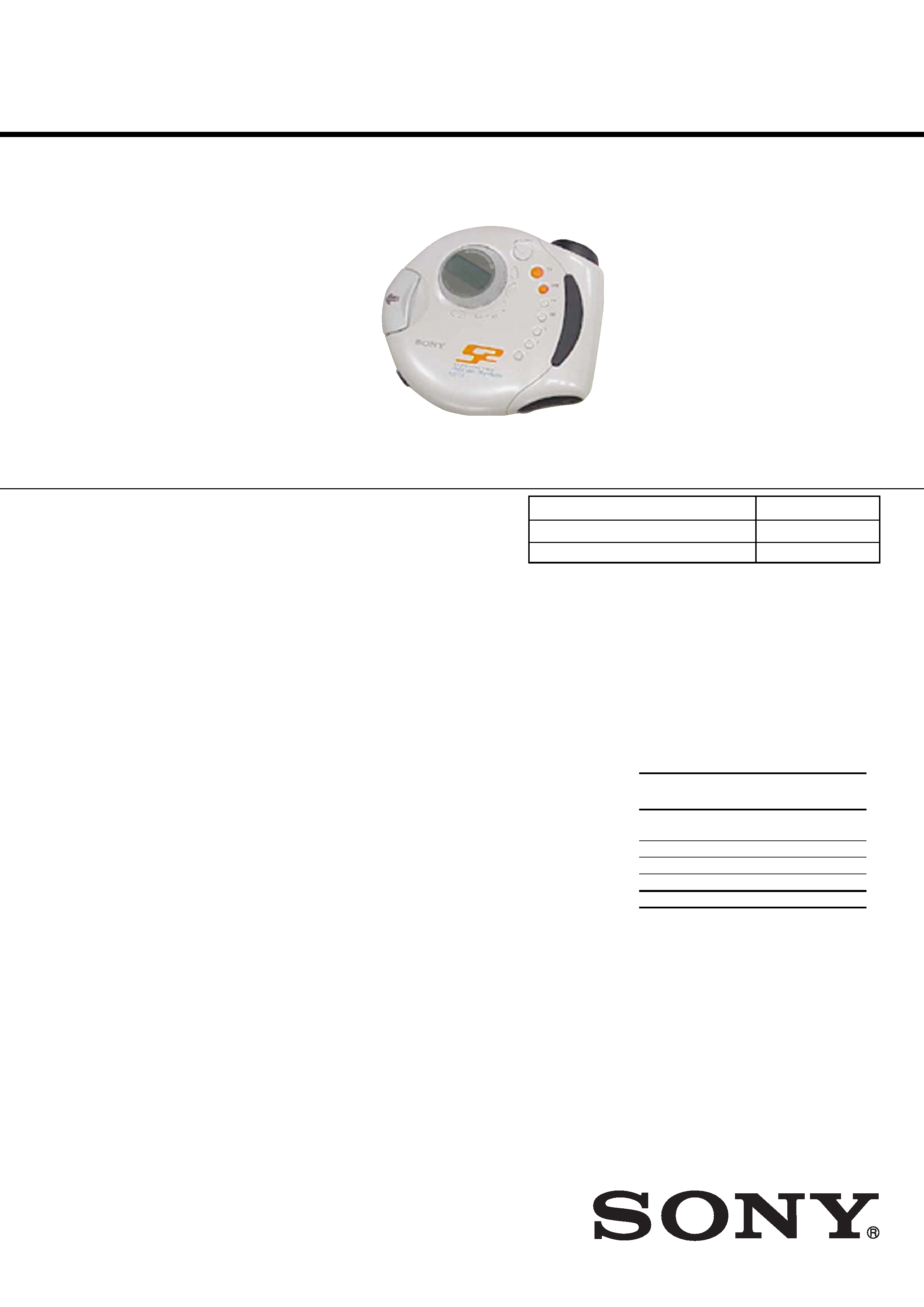
D-NS921F
US Model
Canadian Model
AEP Model
UK Model
SERVICE MANUAL
Sony Corporation
Personal Audio Company
Published by Sony Engineering Corporation
9-877-307-02
2003K16-1
© 2003.11
-- Continued on next page --
SPECIFICATIONS
Ver 1.1 2003. 11
Photo : US model
Model Name Using Similar Mechanism
NEW
CD Mechanism Type
CDM-3325ER2
Optical Pick-up Type
DAX-25E
CD player
System
Compact disc digital audio system
Laser diode properties
Material: GaAlAs
Wavelength:
= 780 nm
Emission duration: Continuous
Laser output: Less than 44.6
µW
(This output is the value measured at a distance
of 200 mm from the objective lens surface on
the optical pick-up block with 7 mm aperture.)
D-A conversion
1-bit quartz time-axis control
Frequency response
20 - 20 000 Hz
+1
2 dB (measured by JEITA CP-
307)
Output (at 4.5 V input level)
Headphones (stereo minijack)
Approx.5 mW + Approx. 5 mW at 16
General
Power requirements
For the area code of the model you
purchased, check the upper left side of the
bar code on the package.
· Sony NH-WM2AA rechargeable batteries:
1.2 V DC
× 2
·Two LR6 (size AA) batteries: 1.5 V DC
× 2
·AC power adaptor (DC IN 4.5 V jack):
US and CND models: 120 V, 60 Hz
AEP model: 220 - 230 V, 50/60 Hz
UK model: 230 V, 50 Hz
Battery life*1 (approx. hours)
(When you use the CD player on a flat and stable
surface)
Playing time varies depending on how the CD
player is used.
When using two Sony alkaline batteries
LR6 (SG) (produced in Japan)
G-PROTECTION function
"1"
"2"
Audio CD
48
43
ATRAC3plus files*2
75
75
MP3 files*3
70
70
RADIO ON
62
*1 Measured value by the standard of JEITA
(Japan Electronics and Information Technology
Industries Association)
*2 When recorded at 48 kbps or 64 kbps
*3 When recorded at 128 kbps
Radio
Frequency range (STEP switch)
9 kHz step:
TV: 2 - 13 ch
WB (weather band): 1 - 7 ch
FM: 87.5 - 108.0 MHz
AM: 531 - 1 710 kHz
·US model
10 kHz step:
TV: 2 - 13 ch
WB (weather band): 1 - 7 ch
FM: 87.5 - 108.0 MHz
AM: 530 - 1710 kHz
Antenna
*(TV/WB/)FM:Headphones/earphones cord
antenna
AM: Built-in ferrite bar antenna
9 kHz step:
FM: 87.5 - 108.0 MHz
AM: 531 - 1710 kHz
10 kHz step:
FM: 87.5 - 108.0 MHz
AM: 530 - 1710 kHz
· Canadian model
*US model only
FM: 87.5 - 108.0 MHz
AM: 531 - 1602 kHz
·Other models
TV/WB/FM/AM PORTABLE CD PLAYER
US model
FM/AM PORTABLE CD PLAYER
EXCEPT US model
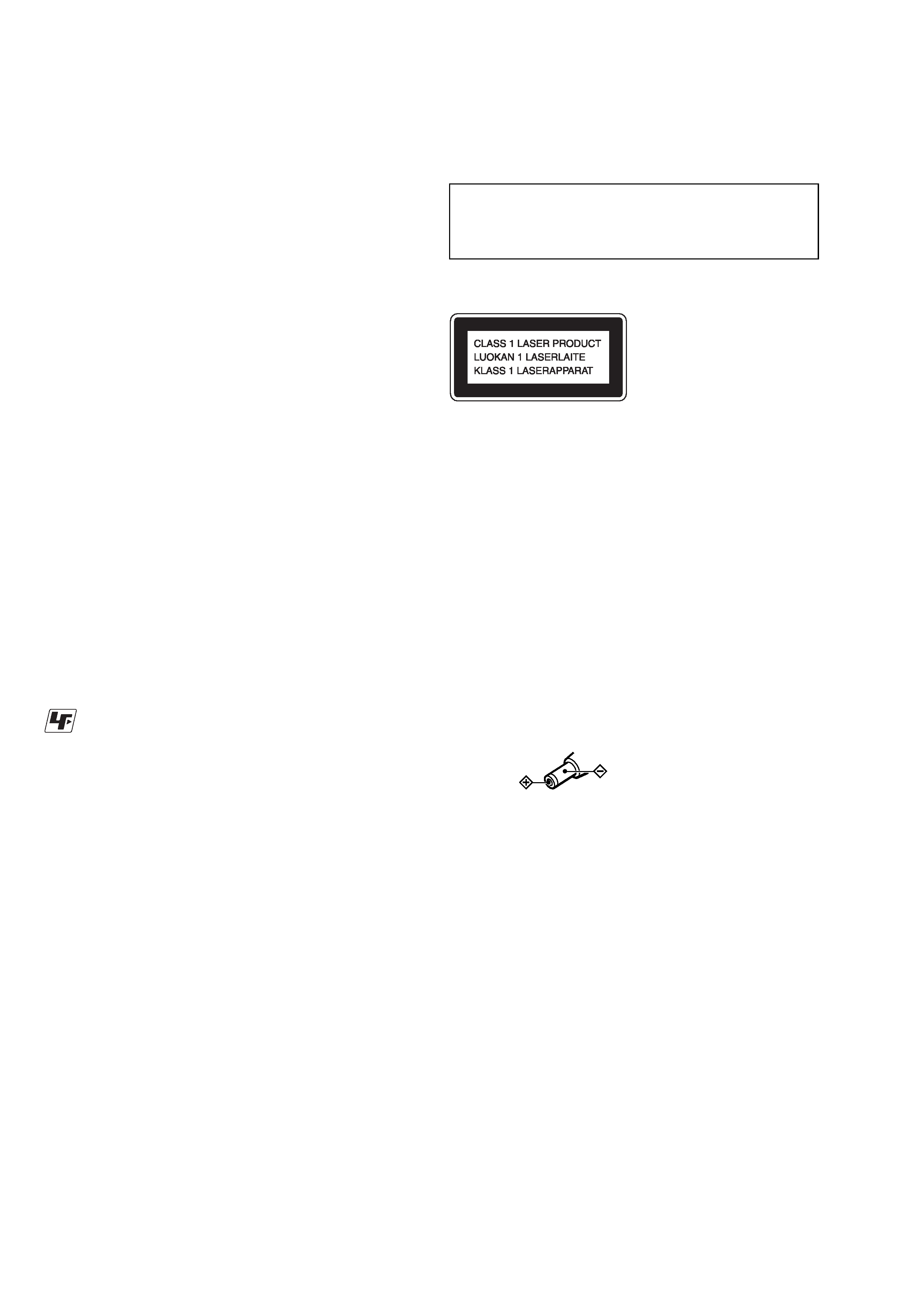
2
SAFETY-RELATED COMPONENT WARNING!!
COMPONENTS IDENTIFIED BY MARK 0 OR DOTTED LINE WITH
MARK 0 ON THE SCHEMATIC DIAGRAMS AND IN THE PARTS
LIST ARE CRITICAL TO SAFE OPERATION. REPLACE THESE
COMPONENTS WITH SONY PARTS WHOSE PART NUMBERS
APPEAR AS SHOWN IN THIS MANUAL OR IN SUPPLEMENTS
PUBLISHED BY SONY.
ATTENTION AU COMPOSANT AYANT RAPPORT
À LA SÉCURITÉ!
LES COMPOSANTS IDENTIFÉS PAR UNE MARQUE 0 SUR LES
DIAGRAMMES SCHÉMATIQUES ET LA LISTE DES PIÈCES SONT
CRITIQUES POUR LA SÉCURITÉ DE FONCTIONNEMENT. NE
REMPLACER CES COMPOSANTS QUE PAR DES PIÈSES SONY
DONT LES NUMÉROS SONT DONNÉS DANS CE MANUEL OU
DANS LES SUPPÉMENTS PUBLIÉS PAR SONY.
D-NS921F
Flexible Circuit Board Repairing
·Keep the temperature of the soldering iron around 270°C during
repairing.
· Do not touch the soldering iron on the same conductor of the
circuit board (within 3 times).
· Be careful not to apply force on the conductor when soldering or
unsoldering.
Notes on chip component replacement
·Never reuse a disconnected chip component.
· Notice that the minus side of a tantalum capacitor may be dam-
aged by heat.
This Compact Disc player is
classified as a CLASS 1 LASER
product.
The CLASS 1 LASER
PRODUCT label is located on
the rear exterior.
CAUTION
Use of controls or adjustments or performance of procedures other
than those specified herein may result in hazardous radiation
exposure.
Laser component in this product is capable of emitting
radiation exceeding the limit for Class 1.
DANGER
Invisible laser radiation when open and interlock failed or defeated.
Avoid direct exposure to beam.
Operating temperature
5
°C - 35°C (41°F - 95°F)
Dimensions (w/h/d) (excluding
projecting parts and controls)
Approx. 148.4
× 134.0 × 36.7 mm
(5 7/8
× 5 3/8 × 1 1/2 in.)
Mass (excluding accessories)
Approx. 345 g (12.2 oz.)
Design and specifications are subject to change
without notice.
Supplied accessories
For the area code of the location in which you
purchased the CD player, check the upper left side
of the bar code on the package.
AC power adaptor (1)
Hand strap (1)
CD-ROM (SonicStage Simple Burner) (1)
User's guide for SonicStage Simple Burner (1)
For US customers
The AC power adaptor supplied is not intended to
Should the AC power adaptor cease to
functionin its intended manner, during the warranty
period, the adaptor should be returned to your nearest
Sony Service Center or Sony Authorized Repair Center
be serviced.
for replacement, or after warranty period, it should be
discarded.
On AC power adaptor
· Use only the AC power adaptor supplied or
recommended in "Accessories (supplied/
optional)." Do not use any other AC power
adaptor. It may cause a malfunction.
Polarity of the plug
·When disconnecting the AC power adaptor
from the AC outlet, grasp the adaptor
itself. Do not pull it by the cord.
· Do not touch the AC power adaptor with
wet hands.
Unleaded solder
Boards requiring use of unleaded solder are printed with the lead-
free mark (LF) indicating the solder contains no lead.
(Caution: Some printed circuit boards may not come printed with
the lead free mark due to their particular size.)
: LEAD FREE MARK
Unleaded solder has the following characteristics.
· Unleaded solder melts at a temperature about 40°C higher than
ordinary solder.
Ordinary soldering irons can be used but the iron tip has to be
applied to the solder joint for a slightly longer time.
Soldering irons using a temperature regulator should be set to
about 350°C.
Caution: The printed pattern (copper foil) may peel away if the
heated tip is applied for too long, so be careful!
· Strong viscosity
Unleaded solder is more viscous (sticky, less prone to flow) than
ordinary solder so use caution not to let solder bridges occur such
as on IC pins, etc.
· Usable with ordinary solder
It is best to use only unleaded solder but unleaded solder may
also be added to ordinary solder.
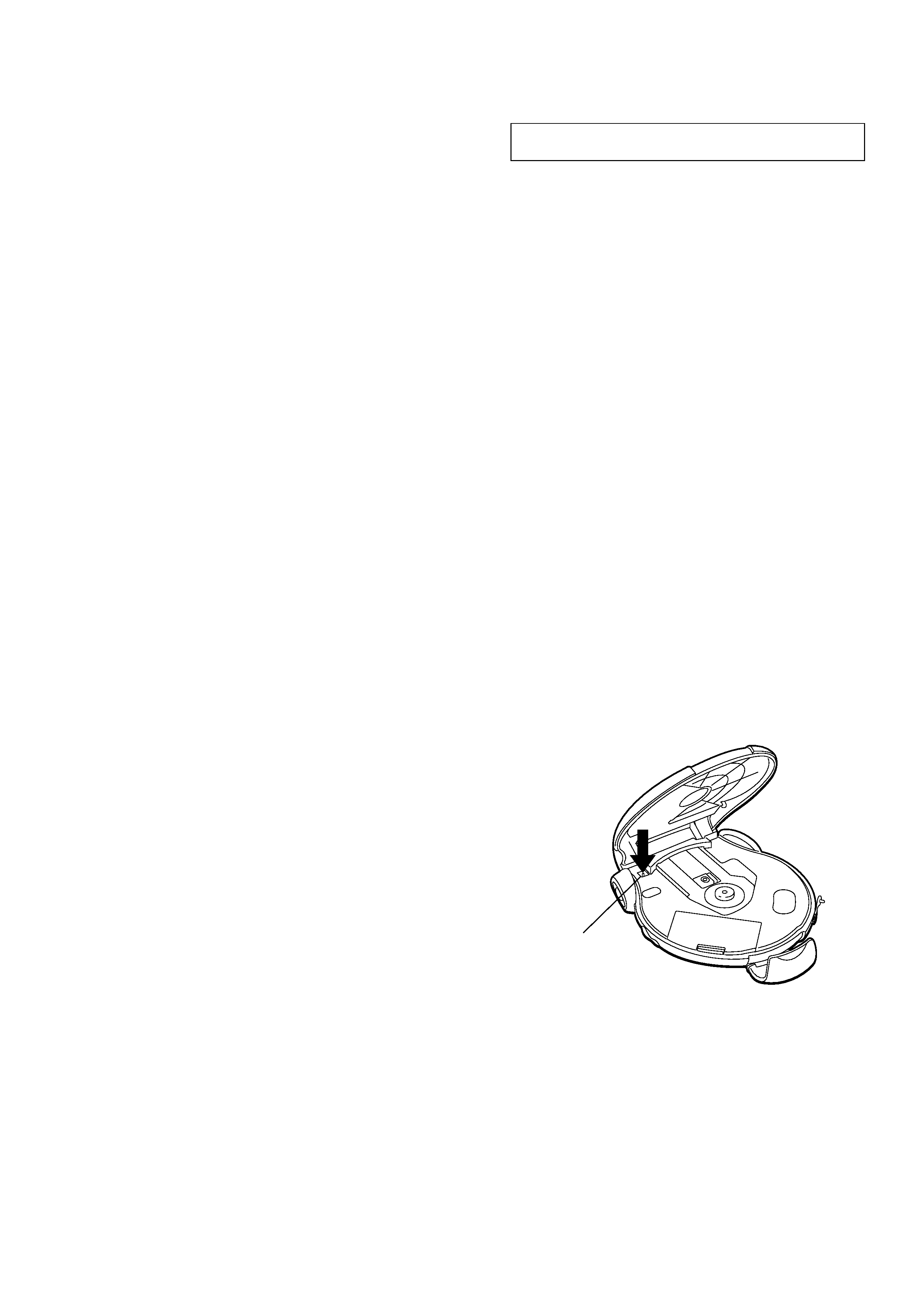
3
D-NS921F
The laser diode in the optical pick-up block may suffer electrostatic
breakdown because of the potential difference generated by the charged
electrostatic load, etc. on clothing and the human body. During repair, pay
attention to electrostatic breakdown and also use the procedure in the printed
matter which is included in the repair parts.
The flexible board is easily damaged and should be handled with care.
NOTES ON LASER DIODE EMISSION CHECK
The laser beam on this model is concentrated so as to be focused on the disc
reflective surface by the objective lens in the optical pick-up block. Therefore,
when checking the laser diode emission, observe from more than 30cm away
from the objective lens.
Before Replacing the Optical pick-up Block
Please be sure to check thoroughly the parameters as per the "Optical pick-
up Block Checking Procedure" (Part No. : 9-960-027-11) issued separately
before replacing the optical Pick-up block.
Note and specifications required to check are given below.
· FOK output : IC601 yg pin (TP601)
When checking FOK, remove the lead wire to disc motor.
· RF signal P-to-P value : 0.45 to 0.65Vp-p
SECTION 1
SERVICING NOTES
Laser Diode Checking Methods
During normal operation of the equipment, emission of the laser diode is
prohibited unless the upper panel is closed while turning ON the S801 (push
switch type).
The following two checking methods for the laser diode are operable.
Method :
Emission of the laser diode is visually checked.
1. Open the upper lid.
2. Push the S801 as shown in Fig. 1 .
3. Check the object lens for confirming normal emission of the laser diode.
If not emitting, there is a trouble in the automatic power control circuit or
the optical pick-up. During normal operation, the laser diode is turned
ON about 2.5 seconds for focus searching.
NOTES ON HANDLING THE OPTICAL PICK-UP BLOCK OR
BASE UNIT
TABLE OF CONTENTS
Fig. 1 Method to push the S801
S801
1. SERVICING NOTES ······················································· 3
2. GENERAL ·········································································· 4
3. DISASSEMBLY ································································ 6
3-1. Front Cabinet, Upper Lid Assy ····································· 6
3-2. MD Assy (CDM-3325ER2), MAIN Board ··················· 7
3-3. Turn Table Motor Assy (Spindle)(M902) ······················ 7
3-4. Motor Assy (Sled)(M901),
Optical Pick-up (DAX-25E) ·········································· 8
3-5. SWITCH UNIT MAIN Board, Hold Lever ·················· 8
4. ELECTRICAL ADJUSTMENTS ································· 9
5. DIAGRAMS ······································································ 11
5-1. Block Diagrams MAIN Section ···························· 12
TUNER Section ····················································· 13
5-2. Printed Wiring Board MAIN Board (Side A) ······· 14
5-3. Printed Wiring Board MAIN Board (Side B) ······· 15
5-4. Schematic Diagram MAIN Board (1/6) ··············· 16
5-5. Schematic Diagram MAIN Board (2/6) ··············· 17
5-6. Schematic Diagram MAIN Board (3/6) ··············· 18
5-7. Schematic Diagram MAIN Board (4/6) ··············· 19
5-8. Schematic Diagram MAIN Board (5/6) ··············· 20
5-9. Schematic Diagram MAIN Board (6/6) ··············· 21
5-10. Printed Wiring Board
SWITCH UNIT MAIN Board ······························· 22
5-11. Schematic Diagram
SWITCH UNIT MAIN Board ······························· 23
5-12. IC Block Diagrams ······················································ 24
5-13. IC Pin Function Descriptions ······································ 26
6. EXPLODED VIEWS ······················································ 33
6-1. Upper Lid Section ······················································· 33
6-2. Cabinet Section ··························································· 34
6-3. Cabinet Lower Section ················································ 35
6-4. Optical pick-up Section (CDM-3325ER2) ·················· 36
7. ELECTRICAL PARTS LIST ······································· 37
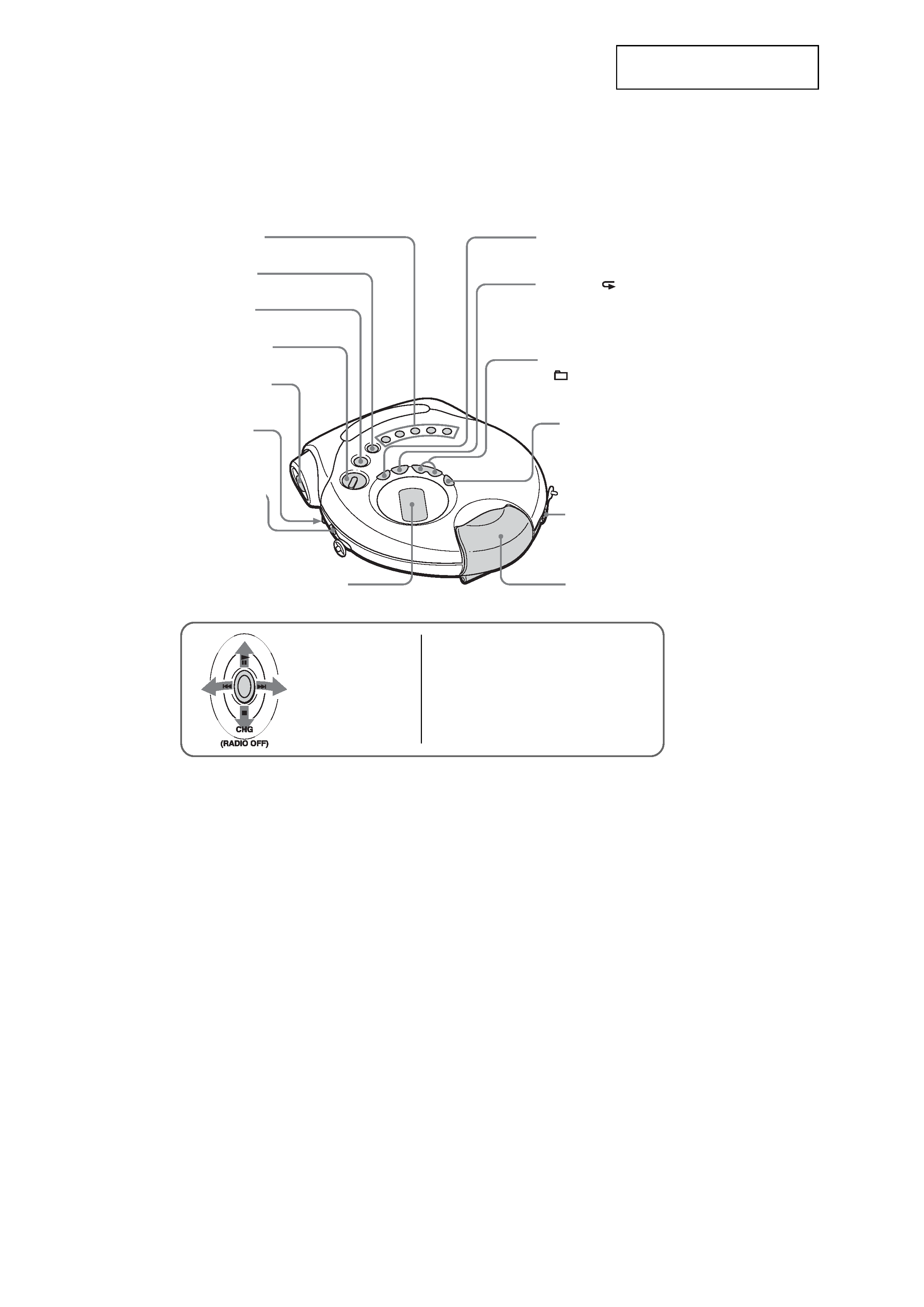
4
D-NS921F
CD player (front)
qd
i (headphones)
jack
(pages 12, 32)
qa TUNING +/·
+/ buttons
(pages 13, 24, 28)
7 DC IN 4.5 V
(external
power input)
jack (pages
12, 33)
2 AM button
(pages 24, 27, 28)
3 FM button
(pages 24, 27, 28)
5 4-way control
key (see below)
4 HOLD switch
(page 31)
6 VOL +*/
(volume)
control
(page 13)
qf Buckle
(page 12)
8 Display (pages 15,18, 21, 22,
24 - 31)
9 SOUND button
(pages 30, 31)
qs DISPLAY
(MEMORY)
button
(pages 26 - 30)
1 1 - 5 buttons
(page 26)
5 4-way control key
Push toward
u,
., > or x·
CHG (RADIO OFF).
u**: Play/pause (pages 13, 18, 20 - 23)
./>: AMS/search (pages 13, 18, 21,
22, 27, 28)
x·CHG (RADIO OFF):
Stop·charge (turn off the radio)
(pages 13, 24, 27, 31, 33)
*
There is a tactile dot beside VOL to show the direction to turn up the volume.
** There is a tactile dot beside
u.
q; P MODE/
(play mode/repeat)
(MONO/ST) button
(pages 18 - 23, 25)
SECTION 2
GENERAL
Locating The Controls
CD player (front)
(Except US model)
This section is extracted from
instruction manual.
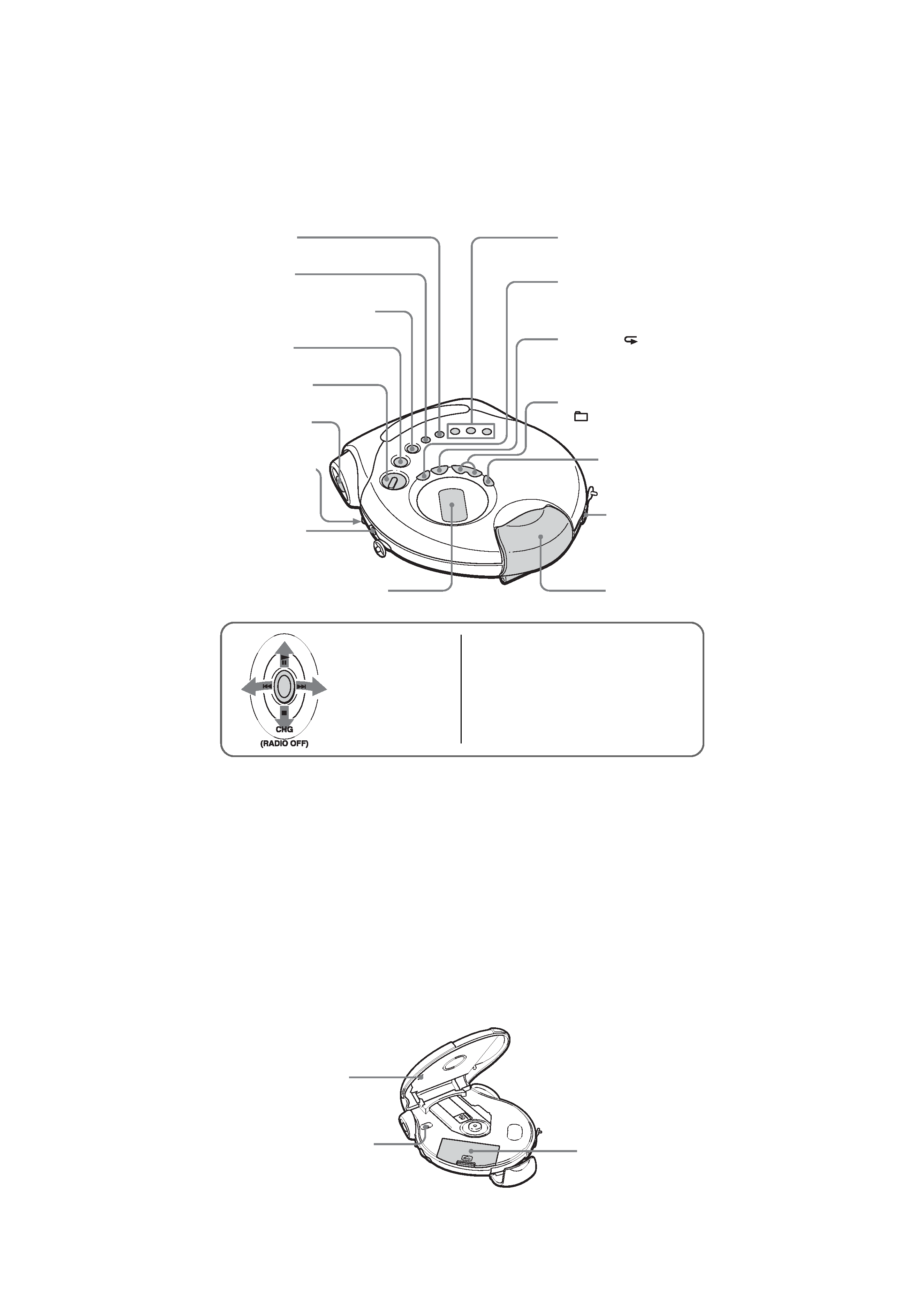
5
D-NS921F
CD player (front)
(US model)
CD player (inside)
CD player (front)
qg
i (headphones)
jack
(pages 12, 32)
qd TUNING +/·
+/ buttons
(pages 13, 24, 28)
8 DC IN 4.5 V
(external power
input) jack (pages
12, 33)
2 FM button
(pages 24, 27, 28)
3 WB (weather band) button
(pages 24, 27, 28)
6 4-way control
key (see below)
5 HOLD switch
(page 31)
7 VOL (volume)
+*/ control
(page 13)
qh Buckle
(page 12)
9 Display (pages 15,18, 21, 22,
24 - 31)
qa SOUND button
(pages 30, 31)
qf DISPLAY
(MEMORY) button
(pages 26 - 30)
1 AM button
(pages 24, 27, 28)
6 4-way control key
Push toward
u,
., > or x·
CHG (RADIO OFF).
u**: Play/pause (pages 13, 18, 20 - 23)
./>: AMS/search (pages 13, 18, 21,
22, 27, 28)
x·CHG (RADIO OFF):
Stop·charge (turn off the radio)
(pages 13, 24, 27, 31, 33)
*
There is a tactile dot beside VOL to show the direction to turn up the volume.
** There is a tactile dot beside
u.
qs P MODE/
(play mode/repeat)
·LOCAL/DX button
(pages 18 - 23, 25)
q; 1 - 3 buttons
(page 26)
4 TV button
(pages 24, 27, 28)
ql Battery compartment
(pages 33, 34)
qk G-PROTECTION
switch
(page 29)
qj STEP switch
(page 28)
